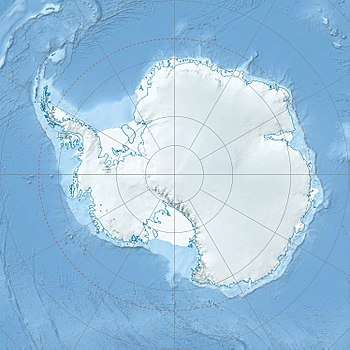Neptune Range
The Neptune Range is a mountain range, 112 km (70 mi) long, lying WSW of Forrestal Range in the central part of the Pensacola Mountains in Antarctica. The range is composed of Washington Escarpment with its associated ridges, valleys and peaks, the Iroquois Plateau, and the Schmidt and Williams Hills. It was discovered and photographed on January 13, 1956 on a US Navy transcontinental plane flight from McMurdo Sound to Weddell Sea and return.

Named by US-ACAN after the Navy 2V-2N Neptune aircraft with which this flight was made. The entire Pensacola Mountains were mapped by USGS in 1967 and 1968 from ground surveys and U.S. Navy tricamera aerial photographs taken in 1964.[1]
Key mountains
- Astro Peak (83°29′S 57°0′W) is a peak, 835 m, standing 1 mile (1.6 km) off the west end of Berquist Ridge. So named by US-ACAN because the USGS established an astro control station on this peak during the 1965-66 season.[2]
- Mount Dasinger (83°13′S 55°3′W) is a mountain, 1,360 m, standing 6 nautical miles (11 km) northeast of Neith Nunatak in northern Neptune Range. Mapped by USGS from surveys and U.S. Navy air photos, 1956-66. Named by US-ACAN for Lieutenant (j.g.) James R. Dasinger, U.S. Navy, of the Ellsworth Station winter party, 1958.[3]
- Mount Torbert (83°30′S 54°25′W) is a prominent, pyramidal rock peak, 1,675 m, midway along Torbert Escarpment in the Neptune Range. Discovered and photographed on January 13, 1956 on the transcontinental nonstop plane flight by personnel of U.S. Navy Operation Deep Freeze I from McMurdo Sound to Weddell Sea and return. Named by US-ACAN for Lieutenant Commander John H. Torbert, U.S. Navy, pilot of the aircraft making this flight.[4]
Key geographical features
- Gillies Rock (83°7′S 54°45′W) is an isolated rock lying 6 nautical miles (11 km) north of Mount Dasinger. Mapped by USGS from surveys and U.S. Navy air photos, 1956-66. Named by US-ACAN for Betty Gillies, ham radio operator of San Diego, CA, who for several seasons from 1960-70 arranged phone patches for members of USGS field parties in the Thiel Mountains, Pensacola Mountains, and elsewhere in Antarctica.[5]
Features
Geographical features include:
Williams Hills
Schmidt Hills
Other features
- Baker Ridge
- Barnes Icefalls
- Bennett Spires
- Berquist Ridge
- Brown Ridge
- Childs Glacier
- Drury Ridge
- Elbow Peak
- Elliott Ridge
- Elmers Nunatak
- Final Rock
- Foundation Ice Stream
- Gale Ridge
- Gambacorta Peak
- Hannah Ridge
- Heiser Ridge
- Hill Nunatak
- Hinckley Rock
- Hudson Ridge
- Jones Valley
- Kaminski Nunatak
- Kinsella Peak
- Loren Nunataks
- Madey Ridge
- Meads Peak
- Median Snowfield
- Miller Valley
- Mount Bragg
- Mount Cowart
- Mount Dover
- Mount Ege
- Mount Feldkotter
- Mount Hawkes
- Mount Kaschak
- Mount Moffat
- Neith Nunatak
- Nelson Peak
- Patrick Nunatak
- Ramsey Cliff
- Rivas Peaks
- Seay Nunatak
- Seely Ridge
- Serpan Peak
- Spanley Rocks
- Torbert Escarpment
- Washington Escarpment
- Webb Nunataks
- West Prongs
- Wiens Peak
References
- "Neptune Range". Geographic Names Information System. United States Geological Survey. Retrieved 2004-11-03.
- "Astro Peak". Geographic Names Information System. United States Geological Survey. Retrieved 2008-03-22.
- "Mount Dasinger". Geographic Names Information System. United States Geological Survey. Retrieved 2010-11-07.
- "Mount Torbert". Geographic Names Information System. United States Geological Survey. Retrieved 2014-05-30.
- "Gillies Rock". Geographic Names Information System. United States Geological Survey. Retrieved 2009-07-06.
![]()